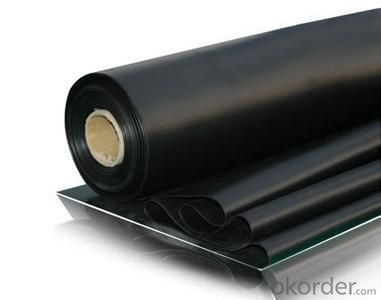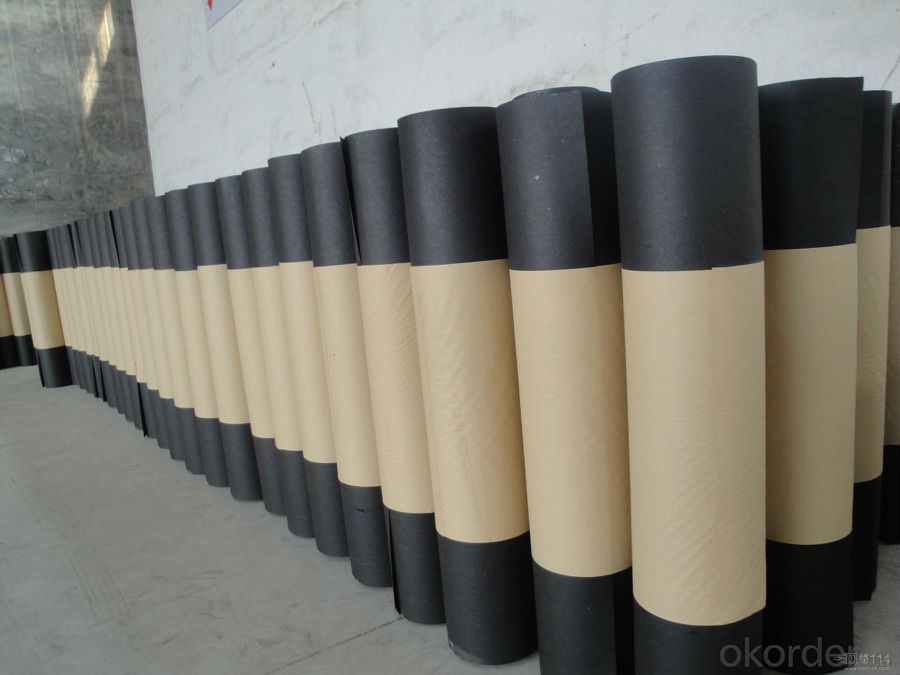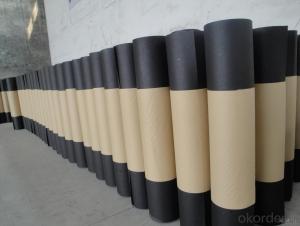EPDM Waterproof Rubber Sheet for Roofing Industry
- Loading Port:
- Qingdao
- Payment Terms:
- TT OR LC
- Min Order Qty:
- 20000 m²
- Supply Capability:
- 600000 m²/month
OKorder Service Pledge
OKorder Financial Service
You Might Also Like
Description Of Waterproof Rubber Sheet for Roofing Industry:
1. EPDM waterproof membrane is made from ternary ethylene-propylene rubber, which is for waterproofing of exposed and non-exposed applications.
2. EPDM waterproof membrane production adopts the world-advanced equipment of cold feeding extrusion and continuous vulcanization technology.
3. EPDM waterproof membrane is of high elasticity among high polymer waterproof materials and becomes a world-popular waterproofing material.
Main Features of Waterproof Rubber Sheet for Roofing Industry:
1. Excellent physical and mechanical performance
2. High tearing resistance
3. Good deformation adaptability
4. High puncture resistance
5. High aging resistance
6. UV resistance
Application of EPDM Waterproof Rubber Sheet for Roofing Industry:
1) Roofs, Basement, Toilet
2) Industrial and civil building waterproofing
3) Geo-synthetic liner for swimming pool, channels, irrigation system
4) Especially suit for projects with high requirements in durability, anti-corrosion and deformation
Technical Parameters of EPDM Waterproof Rubber Sheet for Roofing Industry:
Tensile Strength N/CM | Normal temperature: 60 ; 60°C: 30 |
Breaking Elongation % | Normal temperature: 400 ; -20°C: 10 |
Tear Resistance N | 20 |
Impermeability, 30 min no leakage | 0.3Mpa |
Low Temperature Bending °C | -20 |
Heating Shrinking mm | Extension: 2 Shrink: 4 |
Heat Resistance (80°C×168h) | Tensile Strength % : 80 ; Keeping rate of adhesive breaking:70 |
Alkali resistance (10% ca (oh)2 solution,normal temperature ×168h)) | Tensile Strength % : 80 ; Keeping rate of adhesive breaking:80 |
Synthetic aging | Tensile Strength % : 80 ; Keeping rate of adhesive breaking:80 |
FAQ:
1. What are we supplying?
We are specialized in producing Colorful Asphalt Roof Shingle, SBS/APP modified bitumen waterproof membrane, Self adhesive bitumen waterproof membrane, PVC waterproofing membrane, EPDM rubber roofing membrane, Single Component Polyurethane Waterproof Coating, and Spray Polyurea Waterproof Coating
2. What is your main market?
Our EPDM Waterproof Membrane for Roofing Industry sells very well in USA, United Kingdom, Austrilia, Canada, Japan, Pakistan, etc.
3. What is your advantage for EPDM Waterproof Membrane for Roofing Industry ?
With the most advanced production line, our good quality is based on superior material imported from America.


- Q:How does a waterproofing membrane handle exposure to UV radiation?
- A waterproofing membrane is designed to handle exposure to UV radiation by incorporating UV stabilizers and additives in its composition. These components help to enhance the membrane's resistance to UV rays, preventing degradation and damage over time. Additionally, some waterproofing membranes have reflective properties that can further mitigate the effects of UV radiation. Overall, a well-designed waterproofing membrane can effectively withstand and protect against the harmful effects of UV exposure.
- Q:Can a waterproofing membrane be used for disaster relief structures?
- Yes, a waterproofing membrane can be used for disaster relief structures. Waterproofing membranes are designed to prevent water penetration and can be an effective solution for protecting temporary structures in disaster-affected areas. Whether it is a temporary shelter, medical facility, or storage unit, a waterproofing membrane can provide a barrier against rain, floods, and other water-related challenges. By ensuring that the structure remains dry, it helps maintain the integrity of the relief structure and protects the occupants or stored supplies from water damage. Additionally, waterproofing membranes are often lightweight, easy to install, and can be quickly deployed in emergency situations, making them ideal for disaster relief efforts.
- Q:Can a waterproofing membrane be used in conjunction with sustainable construction materials?
- Yes, a waterproofing membrane can be used in conjunction with sustainable construction materials. In fact, incorporating sustainable construction materials is increasingly becoming a priority in the construction industry due to the need for more environmentally friendly and energy-efficient buildings. Waterproofing membranes can be used to protect sustainable construction materials, such as recycled or low-impact materials, from water damage and moisture infiltration. These membranes create a barrier that prevents water from seeping through the materials, thus prolonging their lifespan and reducing the need for repair or replacement. Additionally, sustainable construction materials are often designed to be more energy-efficient, which can be further enhanced by using a waterproofing membrane. By preventing water damage, the membrane helps maintain the integrity of the building envelope, reducing the potential for energy loss through leaks or moisture intrusion. Moreover, some waterproofing membranes are specifically designed to be more sustainable themselves. For instance, there are eco-friendly membranes made from recycled materials or those that can be recycled at the end of their lifespan. These sustainable membranes minimize the environmental impact associated with their production and disposal. Overall, utilizing a waterproofing membrane in conjunction with sustainable construction materials is a smart and responsible approach to building design. It ensures the long-term durability and performance of the materials, while also contributing to a more sustainable and energy-efficient built environment.
- Q:Can a waterproofing membrane be used for seawalls or bulkheads?
- Seawalls or bulkheads can benefit from the use of a waterproofing membrane. These membranes are specifically designed to create a barrier against water, and they can be applied to various structures, including seawalls and bulkheads. The materials used for these membranes, such as bitumen, rubber, PVC, or polyurethane, are known for their excellent resistance to water and their ability to maintain the integrity of the wall or bulkhead. By applying the membrane to the surface of the structure, a continuous and durable waterproof layer is formed, effectively preventing water from seeping through. This protective layer helps safeguard the seawall or bulkhead from erosion, corrosion, and other types of damage caused by exposure to seawater. Moreover, waterproofing membranes offer additional advantages, including increased durability, improved aesthetics, and enhanced resistance to UV rays and chemicals. In conclusion, the use of a waterproofing membrane is a reliable solution for ensuring the long-term performance and durability of seawalls and bulkheads in marine environments.
- Q:Are waterproofing membranes resistant to sewage?
- Yes, waterproofing membranes are resistant to sewage.
- Q:Does a waterproofing membrane prevent water damage to building materials?
- A waterproofing membrane is specifically designed to shield building materials from water damage. Its purpose is to act as a barrier, preventing water from infiltrating the structure and causing harm. Typically, the membrane is applied to areas prone to water intrusion, such as roofs, basements, and foundations. By creating a watertight seal, it effectively stops water from seeping through and harming the building materials. This safeguard is essential in maintaining the structure's integrity and preventing issues like mold growth, rot, and material decay. However, it's crucial to acknowledge that the effectiveness of a waterproofing membrane can vary based on the product's quality and proper installation. Regular maintenance and inspections are also necessary to ensure the membrane remains intact and continues to safeguard against water damage.
- Q:What are the different thickness options for a waterproofing membrane?
- Waterproofing membranes come in a variety of thickness options to cater to different needs and applications. The thickness of a waterproofing membrane typically ranges from 0.5 millimeters (mm) to 2.0 mm. Thinner waterproofing membranes, such as those measuring 0.5 mm to 0.8 mm in thickness, are often used for applications that require a flexible and lightweight solution. These membranes are commonly used for residential waterproofing projects, such as roof decks, balconies, and basements. They are also suitable for areas that experience minimal foot traffic or where space is limited, as their thin profile allows for easy installation and minimal disruption to the existing structure. Medium-thickness waterproofing membranes, ranging from 1.0 mm to 1.5 mm, are frequently employed in both residential and commercial applications. These membranes strike a balance between flexibility and durability, making them suitable for areas that may experience moderate to heavy foot traffic or where additional protection is required. They are commonly used in areas such as shower enclosures, wet rooms, and exterior walls. Thicker waterproofing membranes, typically measuring 1.5 mm to 2.0 mm, are often preferred for high-demand applications or areas that are exposed to extreme conditions. These membranes offer enhanced strength, resilience, and resistance to punctures and abrasions. They are commonly used in industrial settings, commercial buildings, and civil engineering projects such as tunnels, bridges, and parking structures. It is important to note that the appropriate thickness option for a waterproofing membrane depends on the specific requirements of the project, including factors such as anticipated usage, exposure to moisture, and expected loads. Therefore, it is advisable to consult with a professional or manufacturer to determine the most suitable thickness option for a particular application.
- Q:How does a waterproofing membrane handle structural cracks?
- A waterproofing membrane is designed to handle structural cracks by providing a barrier that prevents water penetration through the cracks. It acts as a protective layer, sealing the cracks and preventing any moisture from seeping into the underlying structure. This helps to maintain the integrity of the waterproofing system and ensures long-term protection against water damage.
- Q:Can a waterproofing membrane be used on balconies and decks?
- Yes, a waterproofing membrane can be used on balconies and decks. Waterproofing membranes are specifically designed to provide a protective layer against water damage, making them an ideal solution for outdoor areas like balconies and decks that are exposed to rain, snow, and other moisture. By applying a waterproofing membrane, you can effectively prevent water penetration, enhance the durability of the surface, and extend the lifespan of your balcony or deck.
- Q:Can a waterproofing membrane be used on gypsum board surfaces?
- Yes, a waterproofing membrane can be used on gypsum board surfaces. Gypsum board, also known as drywall, is a common material used in interior construction. While it is not inherently waterproof, applying a waterproofing membrane can help protect the gypsum board from moisture damage. A waterproofing membrane is a thin layer of material that is applied to the surface of the gypsum board. It forms a barrier that prevents water from seeping into the board and causing it to deteriorate or mold. It can be used in areas where moisture is present, such as bathrooms, kitchens, laundry rooms, or basements. Before applying a waterproofing membrane, it is important to prepare the gypsum board surface properly. This may involve cleaning the surface, patching any holes or cracks, and ensuring the board is dry and free of dust. Once the surface is ready, the waterproofing membrane can be applied according to the manufacturer's instructions. It is worth noting that while a waterproofing membrane can provide some protection against moisture, it is not a guarantee against water damage. It is always important to address the source of water intrusion and ensure proper drainage and ventilation in any area prone to moisture. Additionally, it is recommended to consult with a professional or follow the manufacturer's recommendations when choosing and applying a waterproofing membrane to gypsum board surfaces.
1. Manufacturer Overview |
|
|---|---|
| Location | |
| Year Established | |
| Annual Output Value | |
| Main Markets | |
| Company Certifications | |
2. Manufacturer Certificates |
|
|---|---|
| a) Certification Name | |
| Range | |
| Reference | |
| Validity Period | |
3. Manufacturer Capability |
|
|---|---|
| a)Trade Capacity | |
| Nearest Port | |
| Export Percentage | |
| No.of Employees in Trade Department | |
| Language Spoken: | |
| b)Factory Information | |
| Factory Size: | |
| No. of Production Lines | |
| Contract Manufacturing | |
| Product Price Range | |
Send your message to us
EPDM Waterproof Rubber Sheet for Roofing Industry
- Loading Port:
- Qingdao
- Payment Terms:
- TT OR LC
- Min Order Qty:
- 20000 m²
- Supply Capability:
- 600000 m²/month
OKorder Service Pledge
OKorder Financial Service
Similar products
New products
Hot products
Related keywords































